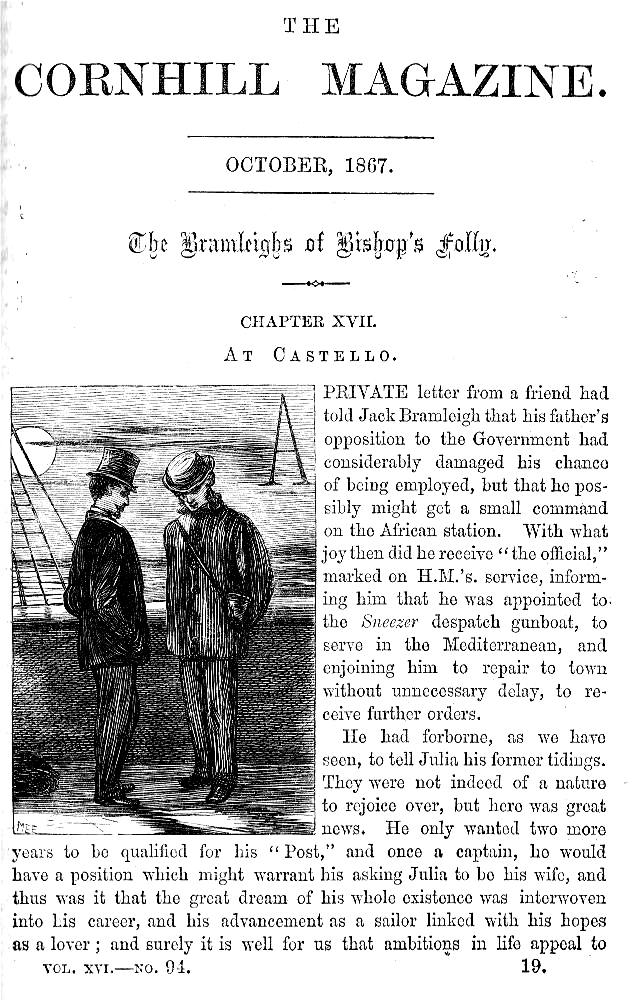

Initial-letter Vignette "A" (Jack Bramleigh and his friend on the deck of a warship) (Vol. XVI, page 385) vertically-mounted, 7.7 cm high by 5.1 cm wide, signed "MEE." in the lower-left corner; also in the lower-left corner of the main illustration. Mary Ellen Edwards, fifth thumbnail vignette illustration for Charles Lever's The Bramleighs of Bishop's Folly in the Cornhill Magazine (October 1867), Chapters XVII-XIX ("At Castello" through "A Departure.") in Vol. 16: pages 385 through 408 (24 pages including unpaged illustration in instalment). The wood-engraver responsible for this illustration was Joseph Swain (1820-1909), noted for his engravings of Sir John Tenniel's cartoons in Punch. [Click on the image to enlarge it; mouse over links.]
This initial-letter vignette introduces the passage on the same page:
A private letter from a friend had told Jack Bramleigh that his father's opposition to the Government had considerably damaged his chance of being employed, but that he possibly might get a small command on the African station. With what joy then did he receive “the official,” marked on H.M.'s service, informing him that he was appointed to the Sneezer despatch gunboat, to serve in the Mediterranean, and enjoining him to repair to town without unnecessary delay, to receive further orders.
He had forborne, as we have seen, to tell Julia his former tidings. They were not indeed of a nature to rejoice over, but here was great news. He only wanted two more years to be qualified for his “Post,” and once a captain, he would have a position which might warrant his asking Julia to be his wife, and thus was it that the great dream of his whole existence was interwoven into his career, and his advancement as a sailor linked with his hopes as a lover; and surely it is well for us that ambitions in life appeal to us in other and humbler ways than by the sense of triumph, and that there are better rewards for success than either the favor of princes or the insignia of rank. [Vol. XVI, Chapter XVII, "At Castello," p. 385]
Commentary: Jack's Unidentified "Friend"
The illustration does not in fact anticipate or realise any event in the instalment. Rather, the initial-letter vignette presents a mystery that only reading the entire chapter will enable us to resolve. The two men appear to be a midshipman and a well-connected, upper-class civilian. Thus, Edwards invites us to construe the miniature as indicating the knowing “friend” who has advised Jack of his promotion by mail. However, by the end of the chapter we may place another, less sanguinary interpretation on the vignette: when Ellen and Jack see Julia out sketching with Lord Cudluff, Jack realizes that the peer could have orchestrated his immediate promotion and necessary departure in order to court the beautiful curate’s sister himself. The fashionably dressed politico on the deck beside Jack May represent the means by which Lord Culduff has effected Jack's unexpected promotion to the H. M. Sneezer behind the scenes in London.
Scanned images and text by Philip V. Allingham. [You may use these images without prior permission for any scholarly or educational purpose as long as you (1) credit the person who scanned them and (2) link your document to this URL in a web document or cite the Victorian Web in a print one.]
Bibliography
Lever, Charles. The Bramleighs of Bishop’s Folly. The Cornhill Magazine 15 (June, 1867): pp. 640-664, and (July-December 1867): 1-666. Rpt. London: Chapman & Hall, 1872. Illustrated by M. E. Edwards; engraved by Joseph Swain.
Stevenson, Lionel. "Chapter XVI: Exile on the Adriatic, 1867-1872." Dr. Quicksilver: The Life of Charles Lever. London: Chapman and Hall, 1939. Pp. 277-296.
Created 28 August 2023